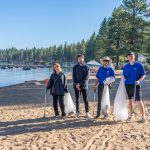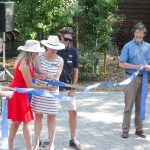California Tahoe Conservancy board meeting: more funding for greenway, equitable recreation
LAKE TAHOE, Calif. – The California Tahoe Conservancy held their last board meeting of the year on Dec. 14, with an even mix of actionable and discussion items.
Expansion of the Dennis T. Machida Memorial Greenway
The board approved an $800,000 grant to the City of South Lake Tahoe for the next section of the Dennis T. Machida Memorial Greenway. This could potentially expand the trail from where it currently ends at Herbert Avenue and extend it to Ski Run Boulevard and Van Sickle Bi-State Park.
The grant will fund feasibility and planning analyses, as well as an environmental review. These phases are set to be completed in 2025 and 2026, respectively.

In addition to its function as a shared use trail, the conservancy lists many benefits this expansion can potentially have. Improving wildlife and driver safety in the area via a wildlife crossing is one of those. A photo of a bear family crossing an existing road in the project area exemplified this need. The greenway also has the potential to improve water quality, equitable access, active transportation, and climate change resilience.
Jason Burke for the City of South Lake Tahoe said after the feasibility and planning analyses, and environmental review are completed in 2026, it’s likely the city will pursue funding for the next step of plan implementation.
Support for equitable recreation
The board approved grant funding totaling $409,000 for four equitable recreation programs involving the basin.
The Tahoe Rim Trail Association received $155,000 to revitalize the Tahoe Rim trailheads. The association plans to update the 12 California trailhead signs with Spanish and English, as well as update trail safety information. The new signs will also bear a tribal land acknowledgment.
The association is intent on getting right to work after they receive the funds. The first steps are designing and building the signs with the goal of positioning them in the summer and fall of 2025.
The association says they are installing signs on the Nevada side this upcoming summer and hopes to send the message that everyone is welcome.
The Tahoe XC’s Las Chicas program is receiving $60,000. The funds will provide middle school aged Latina girls with bilingual instruction, equipment, and transportation for cross country skiing and mountain biking. The conservancy says the program removes barriers to these activities and provides a safe space for participants to recreate with peers of similar culture and background.

The conservancy is also appropriating $84,000 to the Lake Tahoe Waterman Foundation’s adaptive paddling program for under-resourced youth, people confronting physical disabilities, and those facing mental health challenges.
Justin Broglio for the foundation said this will allow organizers to take the program to the next level. The program currently offers half day, full day, and week long options for adaptive water sports. The funds will allow more participants to get involved.
The final programs discussed and funded are the Environmental Traveling Companions organization’s Youth LEAD and Shared Adventures programs. The organization is receiving $150,000 from the conservancy.
Their programs seek to make outdoor activities accessible to those with physical or emotional disabilities, and under-resourced youth. Most participants are from the San Francisco bay areas, and Sacramento. The conservancy says the programs will provide opportunities for those individuals to experience Lake Tahoe, who otherwise wouldn’t.
The Youth LEAD program is a 14 – 21 day outdoor adventure and education course for 14 – 18 year-olds. The program provides outdoor activities in Tahoe, the Bay area, and on the American River.
Their second program, the Shared Adventures Program, teaches safe paddling skills to individuals while participating in a four day kayak trip in Emerald Bay.
Tracking climate goals
Devin Middlebrook of the Tahoe Regional Planning Agency provided an update on a conservancy funded climate tracking tool. The finished online tool will track metrics for climate resilience.
Middlebrook began his update to the board by saying, “I’m preaching to choir a little bit here, but we all know that climate change isn’t some far off thing that’s going to happen at the end of the century. The impacts of climate change are being felt today on our landscape through wildfire, landslides on our highways, drought, and flooding, and the extreme switches between those opposite ends of the spectrum,” displaying images representing those in the Tahoe Basin.
He expressed a need to understand the progress the basin is making on its climate strategies. The website will meet this need and provide an update to their outdated sustainability platform created in 2014.
The climate action reporting and engagement tool will help the basin better understand climate challenges, opportunities, priorities, and maintain accountability.
The tool will track progress over the following four goals with desired outcomes and indicators:
- Changing climate conditions
- Resilient natural systems
- Resilient built systems
- Resilient social systems
Middlebrook explained these goals align with the state’s requirements and will provide a similar shared framework already widely known across the state.
The TRPA’s next steps are designing the dashboard, describing the indicators with data, and soliciting feedback.
The agency plans to present a draft in the first quarter of next year and hopes to have it finalized thereafter.
‘Tiny but mighty’ meadows in climate resilience
Conservancy Senior Environmental Planner Scott Carroll opened up the presentation on wetlands and greenhouse gas monitoring with the agency’s Upper Truckee Marsh project. This is where the conservancy has worked to restore wetlands with multiple projects over the last 22 years after the area was filled-in for development in the fifties and sixties, and the Truckee river channelized there. The most recent project concluded in 2022, where they blocked off a part of the marina to create a wetland near the shore.
Carol discussed how University of Nevada, Reno researchers are studying the site to learn how the area there restored roughly 20 years ago, and the more recent restoration area, capture carbon.
He introduced Associate Professor Ben Sullivan, who described the Sierra Meadows as ‘tiny but mighty’ to the board and presented their potential in climate resilience with their capacity to sequester carbon in soil. Dr. Sullivan described carbon as a key ecosystem property that can truly change the characteristics of an ecosystem.
Some of the element’s attributes in soil are soil volume increases, increased soil water storage, and water purification, he listed. Carbon can also be sequestered in soil for thousands of years, thereby not populating the atmosphere.
The “tiny but mighty” reference comes from Sierra meadows only making up approximately two percent of the landscape, yet retaining 12 – 30 percent of the region’s soil carbon.
So much so, he said, that meadows can impact California’s carbon budget.
In comparison, one acre of meadow can gain as much carbon as 4 – 8 acres of productive upland forests.
On the flipside, unhealthy or hydrologically degraded meadows can become counterproductive and lose carbon at large rates.
Rough estimates using currently available data reveal carbon losses from degraded meadows in the Sierras could be so large they require approximately the entire Tahoe and Plumas national forests to offset them.
Work is currently being done to better measure the losses. Dr. Benjamin hopes to have that data following continued research with the conservancy and other organizations.
He explained many of these carbon losses are occurring due to prior management actions or inactions. Water rerouting, he provided as an example, dried up meadows and allowed upland plants to move in.
This is why they need to conserve healthy meadows, Sullivan said, and give attention to meadows that are unhealthy.
He revealed that one study from his research team shows promising data that management can also repair meadows and allow them to gain carbon again. This data came from a study outside the basin, but Sullivan hopes to apply similar work on the meadows in the Upper Truckee Watershed. Such studies can provide a better understanding that guides policies and regulations.
Board Member Jay Hansen requested data from Sullivan on how much carbon a one acre meadow can sequester. Hansen says this data can be used to leverage funding, providing carbon credits as an example, in which the conservancy can get paid for not developing land because science shows the land is doing something.
Hansen also asked what effective management practices there are to increase soil carbon.
Sullivan said he’s seen restorers hold back water or slow it down to counter the history of channelization and provided other examples.
2024 – 2029 Strategic Plan update
Continued efforts are underway in developing the next five year Strategic Plan, as presented at the meeting. The conservancy hired the outside organization, Crowe LLP, to assist with development.
Crowe has conducted initiatives to gather insights of the agency’s key policy drivers and focus areas, saying they are not doing a re-haul the plan, only refining and updating it.
Crowe Senior Manager Tommy Abeyta laid out the framework of the plan. It consisted of focus areas, strategies, operations plans, and measurements.
He said the plan’s five focus areas are stewardship, restoration, protection, access, and innovation.
August interviews, workshops, and a fall staff retreat lead to the current outline of the future Strategic Plan.
In the new year, Crowe plans on refining this proposed outline while engaging with partners. They hope to have a draft plan released in March and obtain public feedback in April, leading to a finalized version of the plan in June where they will seek board member approval.
The board provided some critiques at the Dec. 14 presentation. A few members recommended working on wording to make it clearer. Others recommended seeking collaborations with other agencies so there is a sense of overarching goals in the basin.
Erosion control project
Board members also approved an erosion control project on one of the conservancy’s properties in Tahoma. It is a part of a larger project in the neighborhood as well as a multiphase project.
This phase is the last phase of the three part project in the surrounding neighborhood. Other phases were completed in 2014 and 2016.
The project provides water quality improvements to help infiltrate stormwater, capture sediment, and improve drainages in neighborhoods.
The improvements planned for the specific conservancy parcel is a vegetated drainage channel. The addition will improve water quality by filtering water through the vegetation. The channel will also reduce storm water volumes.
The conservancy’s next board meeting is March 21, 2024.

Support Local Journalism

Support Local Journalism
Readers around the Lake Tahoe Basin and beyond make the Tahoe Tribune's work possible. Your financial contribution supports our efforts to deliver quality, locally relevant journalism.
Now more than ever, your support is critical to help us keep our community informed about the evolving coronavirus pandemic and the impact it is having locally. Every contribution, however large or small, will make a difference.
Your donation will help us continue to cover COVID-19 and our other vital local news.










